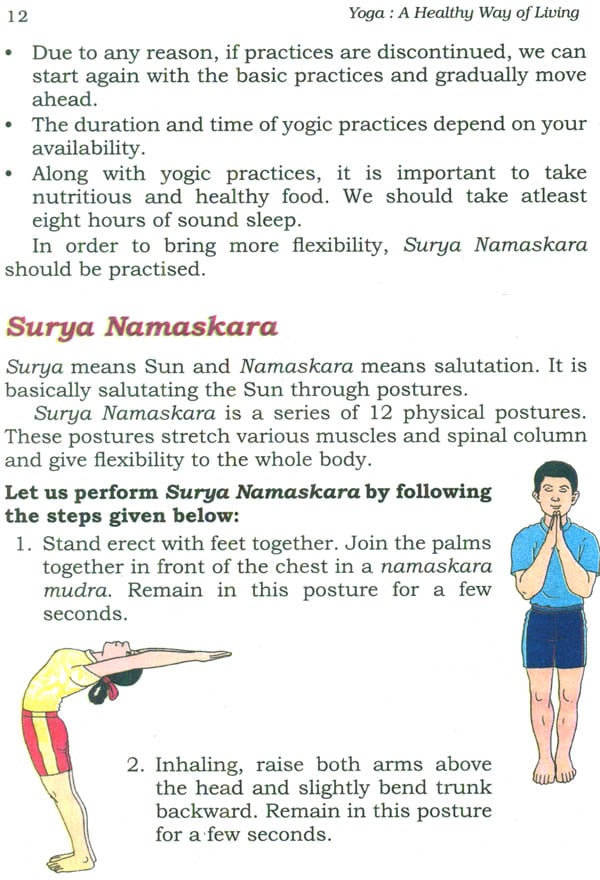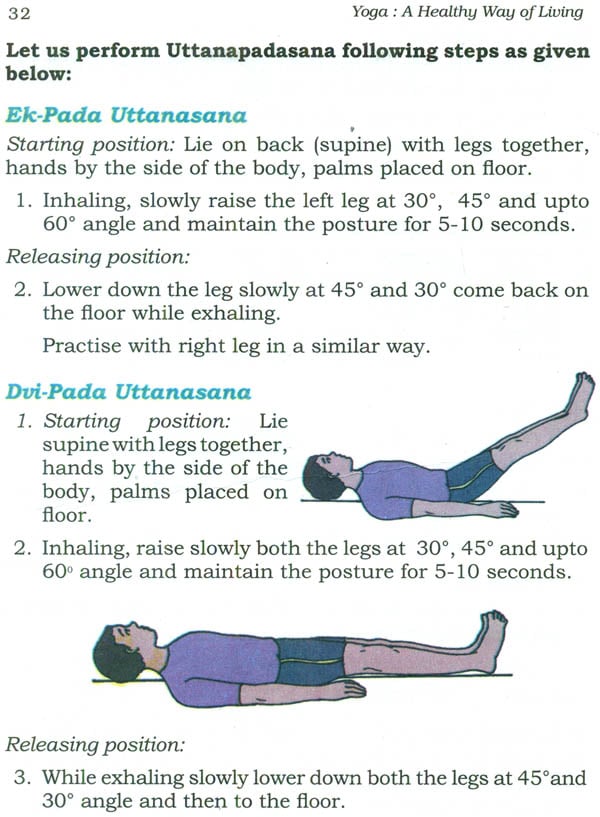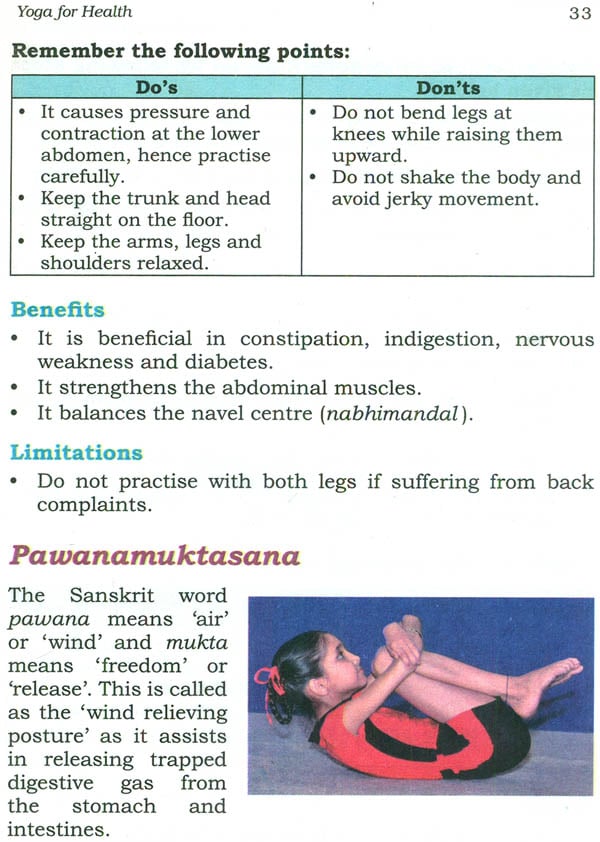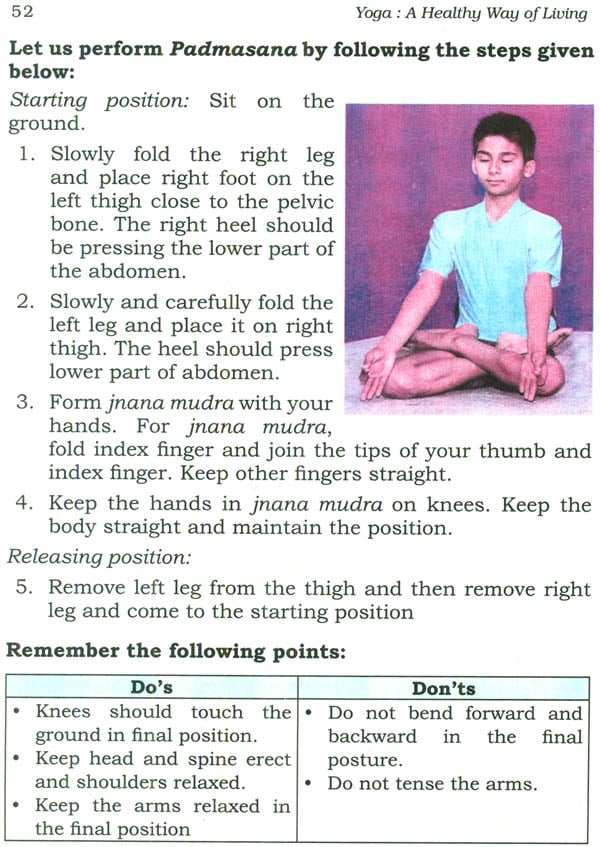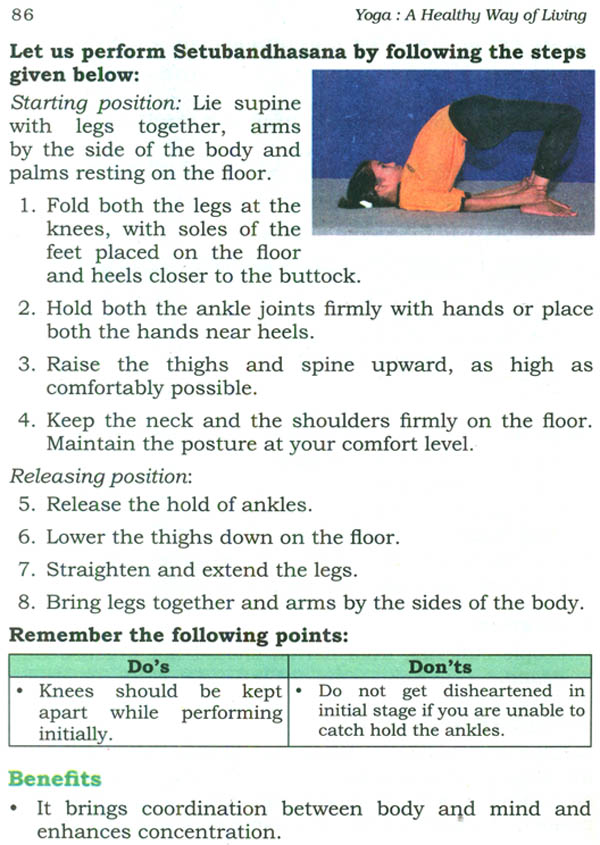
Yoga: A Healthy Way of Living (Upper Primary Stage)
Book Specification
| Item Code: | NAM841 |
| Publisher: | NATIONAL COUNCIL OF EDUCATIONAL RESEARCH |
| Language: | English |
| Edition: | 2015 |
| ISBN: | 9789350073452 |
| Pages: | 112 (102 Color Illustrations) |
| Cover: | Paperback |
| Other Details | 9.5 inch X 7.0 inch |
| Weight | 210 gm |
Book Description
The National Council of Educational Research and Training (NCERT) on the eve of International Yoga Day to be observed on 21 st June has developed textual material on yogic activities for students of Upper Primary and Secondary stages. This textual material is meant for the students of upper primary stage (Classes VI to VIII). It includes various yogic activities to be performed by students of this stage. These activities are an integral part of the syllabi of Health and Physical Education brought out by NCERT. Yoga has been considered to be introduced from the primary level onwards in informal ways, but formal introduction of yogic exercises should begin only from Class VI onwards.
In this textual material, practices of asanas and pranayama have been given importance. Besides asanas, and pranayama, kriyas and meditation have also been included.
This book has four units. The first unit is an introductory, explains in brief the origin and history of Yoga and the general guidelines for doing yogic activities. This unit also includes specific guidelines related to yogic practices (asanas, pranayama, kriyas and meditation, etc.). The second unit is for students of Class VI and whereas the third and fourth units are for students of Classes VII and VIII respectively. In the second, third and fourth units, brief description of each yogic activity, followed by a description of steps or stages for practice have been included. The benefits have been given yogic activity-wise. Some important do's and don'ts including limitations which have to be kept in mind while practising these yogic practices have also been given. A special feature of this textual material is that it is profusely illustrative. Teachers can also learn the yogic activities listed in the syllabus with its help after some initial training in yogasanas. Illustrations have made the material more attractive and user-friendly. The material was developed by a team of experts in yoga and practitioners. We are deeply indebted to all of them for their invaluable help in preparing this textual material. It is hoped that the students and teachers will find it useful.
The National Council of Educational Research and Training (NCERT) takes the pride of contributing through this book entitled Yoga: A Healthy Way of Living meant for school children while celebrating International Yoga Day on 21 June. Yoga is an integral part of 'Health and Physical Education' which is a compulsory subject upto secondary stage. This curricular area adopts a holistic definition of health within which Physical Education and Yoga contribute to the physical, social, emotional and mental development of a child. Yoga has been considered to be introduced from Class VI onwards, though yogic activities may begin in an informal way from primary level onwards. The present book is meant for upper primary stage.
The main emphasis of this textual material is on developing physical fitness, emotional stability, concentration and mental development among the learners. It consists of four units. The first unit is an introductory unit. The other three units give a brief description of Asanas, Pranayamas, Kriyas and Meditation followed by successive actions or steps of these yogic practices. The language and explanations are simple and profusely illustrative so that students can learn and practise it even at home. This material is useful for teachers and others who wish to learn some common and important yogic practices for healthy living. The success of this effort depends on the steps that school principals and teachers will take to encourage children to do these practices and reflect on their learning.
I am highly thankful to Professor Saroj Yadav, Dean (Academic) and Project Coordinator of National Population Education Project (NPEP) and Adolescence Education Programme (AEP) and her team for their continuous effort to develop this material in the present form.
As an organisation committed to systemic reform and continuous improvement in the quality of its products, NCERT welcomes comments and suggestion which will enable us to undertake further revision and refinement.
It is hoped that the students and teachers will find it useful.
Overview
Yoga is a healthy way of life, originated in India. Now, it is believed to be a form of science accepted all over the world. The western culture is also accepting it as a healthy form of scientific exercise. Although the origin of yoga is obscure, it has a long tradition. Yoga for a common person contains the practices of yama, niyama, asana, pranayama, pratyahara, kriya and meditation, which are helpful to keep oneself physically fit, mentally alert and emotionally balanced. This ultimately prepares ground for the spiritual development of an individual.
The main emphasis of the present yoga curriculum for school-going children is to develop their physical fitness, mental development and emotional stability.
Posture or asana form an important basis of this curriculum. These have, therefore, been given more weightage. Though other yogic activities have also been included in the curriculum.
What Is Yoga?
The word 'Yoga' is derived from Sanskrit root yuj which means Join' or 'unite'. This may be taken as the union of body, mind and soul, and is used in the literature both as an end as well as means. As an end, yoga signifies 'integration of personality' at the highest level. As means, yoga includes various practices and techniques which are employed to achieve the development of such integration.
These practices and techniques are means in the yogic literature and are also referred collectively as 'Yoga'.
Importance Of Yoga
Good health is the right of every human being. But this right depends on individual, social and environmental factors. Along with environmental or social factors to a large extent, we can develop a better immune system and a better perception of oneself so that other conditions do not affect us adversely and we can achieve good health.
Health is a positive concept. Positive health does not mean merely freedom from disease, but it also include a jubilant and energetic feeling of well-being with an amount of general resistance and capacity to easily cultivate immunity against specific offending agents.
Yoga is one of the most powerful drugless system of treatment. It is having its own concept of wellness which has been scientifically understood and presented by many. Yoga can be adopted as lifestyle for promoting our physical and mental health. Yoga, if introduced at the school level, would help to inculcate healthy habits and lifestyle to achieve good health.
The aim of yoga thus, at the school level, is to encourage a positive and healthy lifestyle for physical, mental and emotional health of children. Yoga helps in the development of strength, stamina, endurance and high energy at physical level. It also empowers oneself with increased concentration, calm, peace and contentment at mental level leading to inner and outer harmony.
Yoga – Its History
Yoga has its origin thousands of years ago in India. It has originated from a universal desire to attaining happiness and getting rid of sufferings. According to yogic lore, Shiva is considered the founder of yoga. A number of seals and fossil remains of Indus Valley Civilisation, dating back to 2700 BC indicates that yoga was prevalent in ancient India. However, systematic reference of yoga is found in Patanjali's Yogadarshana. Maharishi Patanjali systematised the yogic practices. After Patanjali, many sages/yogis contributed to its development and as a result yoga has now spread all over the world. In this sequence, on 11 December 2014, the United Nations General Assembly (UNGA) with 193 members approved the proposal to celebrate 'June 21' as the 'International Yoga Day'.
Objectives Of Yogic Practices
? To develop a understanding of yogic practices and apply this understanding accordingly in one's life and living.
? To develop healthy habits and lifestyle in children.
? To develop humane values in children.
? To develop physical, emotional and mental health through yogic activities.
General Guidelines for Yogic Practices
Yoga may be introduced from the primary level onwards in informal ways, but formal introduction of yogic exercises should begin only from Class VI. The yoga curriculum must address itself to the children and there should be some hints to them to take up a study of this subject on their own in addition to what is being taught in the class. Yogic activities can be done by all children including children with special needs. However, children with special needs should perform these activities in consultation with yoga experts/yoga teacher as per their capacity.
| Foreword | iii | |
| Unit 1 : | Introduction | 1 |
| Overview | 1 | |
| What is Yoga | 1 | |
| Importance of Yoga | 2 | |
| Yoga - Its History | 2 | |
| Objectives of Yogic Practices | 3 | |
| General Guidelines for Yogic Practices | 3 | |
| Common Yogic Practices | 5 | |
| Yama and Niyama | 5 | |
| Asana | 6 | |
| Pranayama | 7 | |
| Pratyahara | 8 | |
| Bandha Mudra | 8 | |
| Shatkarma / Kriya | 9 | |
| Meditation | 9 | |
| Unit 2: | Yoga for Health | 11 |
| Overview | 11 | |
| Surya Namaskar | 12 | |
| Asanas | 17 | |
| Tadasana | 17 | |
| Vrikshasana | 18 | |
| Utkatasana | 20 | |
| Vajrasana | 22 | |
| Swastikasana | 23 | |
| Ardhapadmasana | 25 | |
| Niralamba Bhujangasana | 27 | |
| Ardhashalabhasana | 28 | |
| Makarasana | 30 | |
| Uttanapadasana | 31 | |
| Pawanamuktasana | 33 | |
| Shavasana | 35 | |
| Breathing with Awareness | 36 | |
| Trataka | 38 | |
| Meditation | 39 | |
| Unit 3 : | Yoga for Physical Fitness | 43 |
| Overview | 43 | |
| What is Flexibility | 43 | |
| Yogic Practices to Enhance Flexibility | 44 | |
| Surya Namaskara | 45 | |
| Asanas | 46 | |
| Tadasana | 46 | |
| Hastottanasana | 47 | |
| Trikonasana | 48 | |
| Katichakrasana | 50 | |
| Padmasana | 51 | |
| Yogamudrasana | 53 | |
| Paschimottanasana | 54 | |
| Dhanurasana | 56 | |
| Makarasana | 58 | |
| Supta Vajrasana | 58 | |
| Chakrasana | 60 | |
| Ardhahalasana | 61 | |
| Shavasana | 63 | |
| Kriya | 63 | |
| Kapalabhati | 63 | |
| Pranayama | 64 | |
| Anuloma-viloma Pranayama | 64 | |
| Bhastrika Pranayama | 66 | |
| Meditation | 67 | |
| Unit 4: | Yoga for Concentration | 70 |
| Overview | 70 | |
| Yogic Practices for Concentration | 72 | |
| Asana | 72 | |
| Garudasana | 73 | |
| Baddhapadmasana | 74 | |
| Gomukhasana | 76 | |
| Ardhamatsyendrasana | 77 | |
| Bhujangasana | 79 | |
| Shalabhasana | 80 | |
| Makarasana | 82 | |
| Matsyasana | 82 | |
| Naukasana | 84 | |
| Setubandhasana | 85 | |
| Halasana | 87 | |
| Shavasana | 89 | |
| Kriya | 89 | |
| Agnisara | 89 | |
| Pranayama | 91 | |
| Anuloma-viloma Pranayama | 91 | |
| Seetkari Pranayama | 91 | |
| Bhramari Pranayama | 93 | |
| Meditation | 94 |

